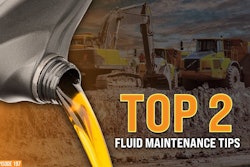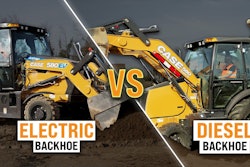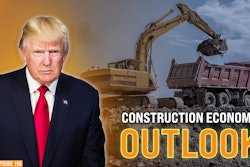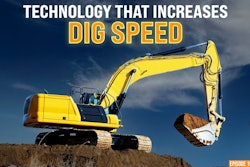One of the big obstacles to electric construction equipment is finding a charging solution for jobsites.
For the past 12 years, Dannar Inc. has been working on the answer, and it has one available now. On this episode of The Dirt, company founder and CEO Gary Dannar explains how this mobile charger can not only serve as a fuel truck by traveling a jobsite with loads of power to charge an excavator or other equipment, but it can also provide support work, such as material handling, lifting and towing.
“This has everyone’s imagination going,” Dannar says, as new uses continue to emerge for the Dannar Mobile Power Station.
The mobile station acts as a go-between from the power source to the equipment, charging batteries rapidly as needed. That means you won’t have to travel or haul an electric excavator to get charged. Instead, the charger comes to the machine.
To learn more about how it works, how fast it can charge equipment and all your other questions about this possible fuel truck of the future, check out the latest episode of The Dirt.
Equipment World serves up weekly videos on the latest in construction equipment, work trucks and pickup trucks – everything contractors need to get their work done. Subscribe and visit us at equipmentworld.com!
In This Episode:
- 00:00 – Dannar Mobile Power Station
- 00:39 – Inspiration Behind the Dannar MPS
- 02:02 – Construction Uses
- 04:20 – Power Capacity
- 06:23 – Charging Speed Output
- 08:03 – Charging Speed Input
- 09:09 – Movement Speed and Off-Road Capabilities
- 11:18 – Dannar MPS Versatility
- 13:30 – Looking Forward
- 17:55 – Final Thoughts
00:00:00:10 - 00:00:22:01
Bryan Furnace
Today we're back with more electric stuff. But today we're not talking about equipment necessarily. We're talking about possibly the fuel truck of the future. One of the biggest hurdles that we talk about when it comes to electric equipment is actual distribution.
00:00:22:01 - 00:00:39:11
Bryan Furnace
How do you get power to your jobsite, let alone to your excavator that is a half mile down the road that you're not going to track back to the charging station? Today we're talking with Dannar, who actually has a solution to that exact problem.
00:00:39:13 - 00:00:48:08
Bryan Furnace
What you guys are bringing to the table is something that no one has ever seen before. Can you give us kind of an overview of what the Dannar platform is?
00:00:48:10 - 00:01:13:15
Gary Dannar
So what was imagined by fleet managers? Construction, agriculture, people, military, large customers of off-road equipment? What was imagined for the last 20 years is a multipurpose vehicle that could work year-round. It can work winter and summer. And over those 20 years, there's been a lot of attachments and tools that have been developed by major global suppliers, equipment manufacturers.
00:01:13:15 - 00:01:50:21
Gary Dannar
I'm sure you're familiar with, you know, different backhoes and snowblowers and trenchers, asphalt planers, all this equipment, scissor lift, forklifts, these have become very, very durable, industrial attachments. And so what we did basically was listen to both camps and see the opportunity to come up with that multipurpose platform that would allow us to receive all those attachments and tools, and then that would mean somebody would be able to have a machine that was very productive, operating in diverse many ways during the winter or in the summer, in the fall or whatever comes up.
00:01:50:21 - 00:02:01:13
Gary Dannar
A climate event, an emergency response event. That was where the idea came from, was from the end users. And it's taken us about 12 years to get to this point.
00:02:01:15 - 00:02:11:03
Bryan Furnace
And so how does the unit kind of apply to our industry in the excavating space? What what kind of things can this do?
00:02:11:05 - 00:02:38:20
Gary Dannar
So I didn't mention that the vehicle is all electric. We are that fuel truck that can be on the jobsite charging up those excavators. And when we're not charging up an excavator, we are working. Perhaps. Maybe we're the forklift or we're towing. Trailers are where have a scissor lift or doing something else. But we're able to be on that jobsite supporting whatever work needs to be done, but also be able to charge up all of those electric machines that are showing up.
00:02:38:22 - 00:03:08:14
Bryan Furnace
Interesting. So so you just kind of shifted my whole mental capacity on this thing. So really what we're talking about is a unit that can carry a tremendous amount of electricity around on a jobsite. So where I immediately go is a lot of the current options out there for charging electric equipment is you've got to set down a stationary station somewhere, and then at the end of the day, or whenever you need to charge your equipment, you have to track that machine over to that charging station, plug it in and let it sit.
00:03:08:16 - 00:03:23:14
Bryan Furnace
And what you're saying is this unit can actually act as a fuel truck for your electric equipment. It can drive itself to the piece of equipment and then offload X amount of charge into that equipment, and then drive itself back to actually go to the charging station.
00:03:23:16 - 00:03:49:09
Gary Dannar
And you got it. That's exactly right. So you know, the easiest way to picture this is a lot of job sites, construction sites. There will be a diesel fuel tank onsite quite large. And so fuel trucks are coming in and filling up that fuel tank. And either fuel is gathered there in a pickup and deliver it out to an excavator, or you're going to have to drive the excavator all the way back to the fuel tank.
00:03:49:11 - 00:04:13:02
Gary Dannar
So boxes of energy started showing up very quickly, especially in Europe and North America. Containers full of batteries. What's missing is the charger piece, perhaps. And also these job sites are quite large, sometimes a mile wide, you know, and we're able to go to that box of energy and grab the energy. We can grab it from the grid, we can grab it from 483 phase.
00:04:13:08 - 00:04:20:08
Gary Dannar
We can grab it in many, many different ways. We get it on board, and then we can deliver it out to the machines where they're at.
00:04:20:10 - 00:04:34:14
Bryan Furnace
So just out of curiosity, how much power are we talking about this thing carting around the jobsite and do the modules that you can kind of outfit, whether it's the loader, bucket or the fork arms or whatever, does that impact the amount of power you can carry around?
00:04:34:16 - 00:05:09:09
Gary Dannar
Yes. There has to be somewhat of a choice made, and it's pretty simple. Do you want it to work all the time and carry a lot of energy for its own purpose? Or do you want it to be a charge or delivery of energy in multiple ways? And then there's a hybrid kind of 5050, but to kind of give you an idea, you know, the machine was envisioned a long time ago that it has to be all electric all day, and we have proven that we can carry enough energy to work more than one day, depending on what you're doing, of course, but we can work multiple days, so it's not a party trick electric
00:05:09:09 - 00:05:33:16
Gary Dannar
machine. That just kind of demonstrates the feasibility of something. This is something that is available now and working now and being very safe and productive. So 500kW, that's about 17 days to power an average house. And so a lot of energy on board. And that's what we're carrying can carry. But now giving energy off over 17 days is one way to do it.
00:05:33:16 - 00:05:58:10
Gary Dannar
But some of these excavators you're talking about, some of those have 200- and 400-kilowatt hour batteries on board. And they want that energy given up like over lunch. And we're able to give it up fast as well. So, you know, as you know, a machine that's working really hard might put 1000 hours a year or 2000 hours a year or less.
00:05:58:12 - 00:06:23:16
Gary Dannar
You you would know this better than most. A lot of machines are working full time, a lot of others that you have to have their, they're working less than that. So there's opportunities to charge those opportunities, maybe over lunch or over a break or over a shift. And our machine can fill that void. So you know that excavator, as soon as it stops a for a couple of hours or lunch, we can charge it back up.
00:06:23:18 - 00:06:53:15
Bryan Furnace
So thinking about this and continuing, because I think it's easy for me and the industry to think about this in terms of the kind of diesel counterpart that we already used to. Does the unit have the ability to charge multiple electric vehicles at one time, and are there really restrictions on how quickly it can offload that power? It's my understanding currently that whether we're talking to an electric vehicle or electric equipment, it's not so much the batteries that are the limitation.
00:06:53:15 - 00:07:16:06
Bryan Furnace
It's more that there are restrictions on how much they allow that machine to take on quickly when it comes to energy. So assuming that someone developed an excavator, for example, that could take a lot of energy very quickly. I mean, is there the potential that you could offload that energy over the course of a 45 minute or so lunch break and really get that machine charged up, even, you know, 50 to 75% back to full charge?
00:07:16:08 - 00:07:39:03
Gary Dannar
Absolutely. We're doing that now. I mean, that's exactly where a lot of these machines are needing to support. We're charging up aircraft that have become electric. We're charging up things that we never imagined. Quite honestly, but we have always engineered the machine to be very flexible in the rate of discharge and the rate that we can take on the charge.
00:07:39:05 - 00:08:03:08
Gary Dannar
You know, we can charge up overnight, if that's what's available. And obviously, if a machine doesn't have a big charger on board and it needs to charge up overnight, well, then we could give it up overnight. But depending on the machine and the use case kind of determines on how fast they can receive the charge. And we can usually match whatever is on board.
00:08:03:10 - 00:08:09:01
Bryan Furnace
Interesting. So 500kW is what you said this thing will hold.
00:08:09:02 - 00:08:09:17
Gary Dannar
Yes.
00:08:09:17 - 00:08:22:08
Bryan Furnace
So that's that's a fair amount of juice. How long does this thing take to charge up? Am I am I leaving this on the charger for three days so I can go charge up three pieces of equipment? How long does it really take?
00:08:22:10 - 00:08:43:22
Gary Dannar
Well, if we charge it up out of my garage, it might take three days or more. Because, you know, I can only give it up. Fair enough. But we're bidirectional charging, so we can charge up as fast as we can deliver it. It works by directionally. So if I mentioned 200kW and 400 kilowatt, those are some common sizes.
00:08:43:22 - 00:09:08:10
Gary Dannar
For some of these electric excavators. We can give up 250kW in an hour. So if an excavator has a 200-kilowatt hour battery and it finds itself at lunchtime getting a little low, we can charge that up over lunch. Now, if it has a 400-kilowatt hour battery, once again, it may not be completely out, but we can charge that up in a couple of hours.
00:09:08:12 - 00:09:30:05
Bryan Furnace
Oh boy. This is this is fascinating. Now, now here's my next question I envision. You're talking about an electric drive unit. And and it's this giant brick of a battery on wheels. I'm envisioning this thing crawling along like the electric scissor lifts that we see in warehouses and everything. What's the actual top speed? How quick can this thing move across a jobsite?
00:09:30:05 - 00:09:41:22
Bryan Furnace
And how rough of terrain can this thing traverse? Can it really get out there to my excavator in the field?
00:10:19:22 - 00:10:41:00
Gary Dannar
No, I love that question because we say we're the fastest thing 0 to 25 miles an hour on wheels. Even though this is a 20,000-pound machine, it's like a tractor loader, backhoe or the size of it. And so forth. They pull that. We have 600,000 pounds of pull, drawbar pull. We can pull a 737 around our an airport tarmac.
00:10:41:03 - 00:11:01:06
Gary Dannar
But you know, electric it is massive amounts of torque available right now when you need it. So we have a lot of power and it's very quick. But it only goes 25 miles an hour. And that's because it's an off-road vehicle just like your backhoes. But you can drive it down the road. 25 this was based on a military version.
00:11:01:08 - 00:11:18:06
Gary Dannar
Rough terrain, 20,000-pound forklifts. Right. There's thousands of those machines out working over the last 30 years. So that's really our platform that we're we're using. So we can go just about anywhere. Rough terrain, three feet of water, things like this. You know.
00:11:18:08 - 00:11:54:15
Bryan Furnace
That's interesting. You talk about that sort of a draw bar pool where where I go mentally is now you've got a unit on site that, assuming you're starting to convert over to the electric side of the industry, now you've got a unit on site that not only can rapid charge all of your electric needs out there, but also if I get into a pinch and get a piece of equipment stuck, instead of having to down one of my dozers or one of my excavators to come over and pull whatever piece is stuck out, you've got a unit that weighs a pretty hefty amount that has four electric drive motors, which get insane traction.
00:11:54:15 - 00:11:58:19
Bryan Furnace
I'm sure you guys have some sort of traction control on the unit internet. My correct there and that assumption.
00:11:59:00 - 00:12:23:11
Gary Dannar
Yeah, I can describe the powertrain, but you're going in the right direction. I appreciate the question. This can obviously pull multiple trailers. It can pull things, but it can retrieve you know, we have one of our machines that has a large winch on it. But customer has put a great, you know, large electric winch on there. Yeah, I use that in the river to be pulling logs out and so forth.
00:12:23:16 - 00:12:59:15
Gary Dannar
But the nice thing about our undercarriage, we'll call it the powertrain, is this is rough terrain, axles that are limited slip, four-wheel drive, four-wheel steer axles. But with electricity you can dial in the torque and control those wheels like the second hand on a clock. So in agriculture, where we have sold machines, they have machines that go through fields at less than a walking pace because they're actually harvesting and working, you know, alongside a machine that is just crawling along.
00:12:59:17 - 00:13:27:21
Gary Dannar
We have a cruise control feature that allows this machine to carry, you know, very large harvesting equipment, but move through the field at the same pace. Someone's walking or even slower. So we've been able to see when we're wanting to pull somebody out or push, we can do that as gently and carefully without losing traction. That's that's the advantage of an electric drive, you know, undercarriage.
00:13:27:23 - 00:13:46:10
Bryan Furnace
Yeah. This is interesting. So now you have my mind kind of spooling. But I should really ask you, since you guys are kind of on the development side, what does a future job site look in your eyes with this sort of technology being available? Where where do we go with this and how does it evolve over time?
00:13:46:12 - 00:14:16:02
Gary Dannar
So we get to see glimpses of the future of agriculture, the future of mining, the future of airport and the future of construction sites. And, you know, this is this has everyone's imagination going because there will be a transformation. I don't think anyone believes diesel fuel, jet fuel, liquid fuel will go away by any means. The amount of energy that can be contained in a gallon of diesel is amazing, and there will always be a need for that.
00:14:16:04 - 00:14:51:22
Gary Dannar
However, these electric machines are now in place in mining, have been in mining a long time, and construction sites and agriculture and emergency responders. And we're starting to recognize that there's a lot of use cases that electric is absolutely perfect. It brings more safety, more productivity. And lower cost of maintenance. So as we go forward, you just see more and more machines all making that transformation to electric, and you'll see more energy onsite coming in boxes or coming on wheels on a trailer.
00:14:52:00 - 00:15:12:06
Gary Dannar
You'll see more mobile power stations like ours show up that are filling that role. And being that final last mile, we'll call it delivery of energy to where it needs to go. And you'll see batteries in 500kW become somewhat, normal and maybe a megawatt of charging on wheels.
00:15:12:08 - 00:15:33:18
Bryan Furnace
It is it is interesting. You know, right now the industry is very, you know, the knee jerk reaction is that electric stuff's never going to work. And what I think the actual reality is, is we're only a battery iteration or two away from the script, totally flipping over to, boy, we can pack a whole lot of power into a unit.
00:15:33:20 - 00:16:05:02
Bryan Furnace
And now when you compare an electric actuator or an electric drive motor to its hydraulic or mechanical transmission counterpart, there's no comparison at the power output you're getting. I mean, anyone who's ever been in an electric vehicle so far knows that you simply cannot compare the speed of an electric motor to the speed of a combustion engine. And once that switch happens, that's where I see this technology, especially just taking off like wildfire, because we're already used to the system that you're describing.
00:16:05:02 - 00:16:24:08
Bryan Furnace
Exactly. We have our equipment on site. We gather around the fuel truck once or twice a day, depending on the application. Everyone fills up and then you go back to work. I see this switch coming a lot quicker than I think a lot of the industry does. It's like I said, it's just going to take that next big leap in battery technology to get us there.
00:16:24:10 - 00:17:08:11
Gary Dannar
Yeah. You're correct. I think the reason it's taken a while, perhaps, for people to recognize it is that the early adopters are the ones that recognized, the advantages of electric machinery. It's the underground mining industry. And they are ten years ahead of everybody else. If you think about a construction site above ground, even when the machine is not digging hard, working hard, and it's cycling hard, easy, hard, easy, the engine is always running, the fuel is always being consumed, and the heat is going right out, and the energy is going right out the exhaust underground.
00:17:08:11 - 00:17:37:10
Gary Dannar
That's a problem. Getting rid of the heat is is a huge problem for underground work. In fact, they have great ventilation systems and, you know, ways to try to excavate. You know, get clear all of that heat. So an electric quiet machine that when it's idling it means it's off. It's not spending one electron at all. It's quiet and it's instantaneous when it needs to work.
00:17:37:12 - 00:17:55:02
Gary Dannar
I mean, it's perfect use case for mining. But those use cases now, as the as I'm sure machines are maturing, those use cases are showing up everywhere. And you have to ask yourself why? Why do I not want to change to an electric, solution?
00:17:55:04 - 00:18:02:22
Bryan Furnace
Yeah. Well, this is fascinating, Gary, thank you so much for the time and and kind of introducing us to the Dannar unit. We appreciate that.
00:18:03:00 - 00:18:05:22
Gary Dannar
Oh, it's been my pleasure. Thank you very much for having me. Yeah.
00:18:06:00 - 00:18:22:10
Bryan Furnace
Well, thank you again for Dannar coming on to talk about their unit and what it's capable of and kind of giving us a little bit of a window into the job side of the future and what our job sites will look like as electricity slowly takes over. As always, I hope you guys find this helpful to your business.
00:18:22:12 - 00:18:24:00
Bryan Furnace
Catch you on the next episode of The Dirt.









